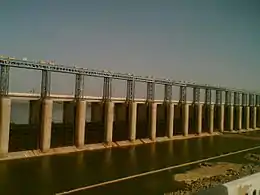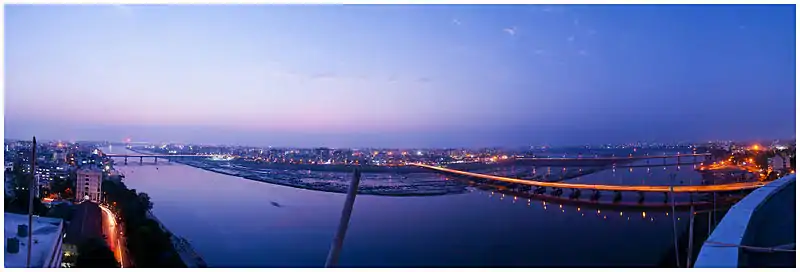Tapti River
The Tapti River (or Tapi) is a river in central India between the Godavari and Narmada rivers which flows westwards before draining into the Arabian Sea.[2] The river has a length of 724 km.[3] Its origin is near Multai Reserve forest in MP. From there it enters Maharashtra and flows through western part of Vidarbha and Khandesh. From Maharashtra it flows into Gujarat, where its mouth is near Surat.[2] It flows through Surat, and is crossed by the Magdalla, ONGC Bridge.[4]

| Tapti Tapi | |
|---|---|
.jpg.webp) | |
| Location | |
| Country | India |
| State | Madhya Pradesh, Maharashtra, Gujarat |
| Cities | Multai, Burhanpur, Bhusawal, Surat |
| Physical characteristics | |
| Source | Multai, Madhyapradesh |
| Mouth | Gulf of Khambhat (Arabian Sea) |
• location | Dumas, Surat, Gujarat |
| Length | 724 km (450 mi)approx. |
| Basin size | 62,225 square kilometres (24,025 sq mi) |
| Discharge | |
| • location | Dumas Beach[1] |
| • average | 489 m3/s (17,300 cu ft/s) |
| • minimum | 2 m3/s (71 cu ft/s) |
| • maximum | 9,830 m3/s (347,000 cu ft/s) |
On 7 August 1968, before the construction of the Ukai Dam to bring its waters under control and provide hydroelectric power, the Tapti River overflowed its banks during heavy rains during the monsoon season. More than 1,000 people drowned in the flood,[5] and the city of Surat was submerged beneath 10 feet of water for several days.[6] After the floodwaters receded, at least 1,000 more people died in Gujarat state during a cholera epidemic from the contamination of the drinking water.[7]
Etymology
The river is supposedly named after the goddess Tapati, the daughter of Surya, the Sun god and Chhaya. Tapati is the sister of Shani, Bhadra, Yamuna and Yama.[8]
See also
References
- "Tapti Basin Station: Kathore". UNH/GRDC. Retrieved 1 October 2013.
- "Tapi River / Tapti River". mapsofindia.com. Retrieved 24 March 2020.
- "Narmada, Water Resources, Water Supply and Kalpsar Department, (Water Resources Division)". Retrieved 9 July 2020.
- "Truck falls into Tapi River from Magdalla Bridge, driver missing". The Times of India. Bennett, Coleman & Co. 31 May 2016. Retrieved 12 June 2016.
- Associate Press (13 August 1968). "1,000 Believed Dead In India Flooding". Pittsburgh Post-Gazette. p. 1. Retrieved 24 February 2019.
- "Western India Town Under 10 Feet Of Water; Flood Toll Hits 1,000", Indianapolis Star, 15 August 1968, p2
- Lee Allyn Davis, Facts on File: Natural Disasters (Infobase Publishing, 23 June 2010) pp166-167
- Mittal, J.P. (2006). History of ancient India : a new version. New Delhi: Atlantic. p. 412. ISBN 9788126906161. Retrieved 21 July 2016.
External links
| Wikimedia Commons has media related to Tapti River. |
| Wikisource has original text related to this article: |

